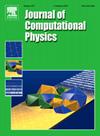基于激波拟合方法的可压缩流动高阶多层紧凑格式(MLC-SF
IF 3.8
2区 物理与天体物理
Q2 COMPUTER SCIENCE, INTERDISCIPLINARY APPLICATIONS
引用次数: 0
摘要
直接数值模拟(DNS)通常采用高阶数值方法,以较少的自由度达到所需的精度,从而提高计算效率。为了进一步提高全局空间精度,Bai和Zhong提出了多层紧凑(MLC)方案(JCP, 2019),以引入空间导数作为新的自由度,并在相同的空间精度下创建更紧凑的模板。稳定性分析表明,MLC可以在封闭边界下达到7阶全局精度,优于大多数六阶常规迎风有限差分格式。尽管具有高阶收敛速度,MLC在超音速流动模拟中仍面临挑战,主要是由于激波中的吉布斯现象。在高阶数值格式中,如果没有附加的处理,如冲击波捕获或冲击波拟合方法,数值振荡会引起发散。因此,需要进一步的研究来提高MLC在实际高速流动应用中的适用性,特别是在激波处理和边界条件实现方面。本文提出了一种新的MLC方法,以提高其在超声速流动模拟中的适用性。该方法将MLC与激波拟合方法(MLC- sf)相结合,将激波作为分离上下游解的计算边界。激波拟合方法减轻了非连续界面上的伪数值振荡,保持了MLC-SF的高阶精度。此外,本文还介绍了激波后MLC-SF空间导数层的物理一致边界条件。该边界条件利用通量雅可比矩阵的反演来估计正确的空间导数,保证了MLC-SF值与入流边界导数层之间的一致性。为了系统地对所提出的方法进行基准测试,将MLC-SF应用于线性平流、Euler和Navier-Stokes方程在一维和二维域上的五种模拟情况。研究案例旨在比较冲击拟合和冲击捕获方法的结果,在任意拉格朗日-欧拉(ALE)框架下评估MLC-SF在移动网格应用中的性能,并在涉及非笛卡尔网格的流体力学问题上测试MLC-SF的导数层。在一维和二维激波相互作用情况下,所提出的物理一致流入条件下的MLC-SF均达到7阶空间精度,优于其他4种测试方法。值得注意的是,在一维激波相互作用结果中,五阶WENO方法在激波后仅显示出一阶精度,这突出了采用激波拟合方法来保持MLC-SF高空间精度的必要性。在计算效率方面。与传统的高阶有限差分激波拟合方法相比,MLC-SF在求解类shu - osher问题时可节省至少30%的计算时间。本研究的总体目标是建立一个适用于可压缩和高速流体力学模拟的高阶MLC框架。本文章由计算机程序翻译,如有差异,请以英文原文为准。
Very high-order multi-layer compact schemes with shock-fitting method (MLC-SF) for compressible flow simulations
High-order numerical methods are commonly employed in direct numerical simulation (DNS) to achieve the required accuracy with fewer degrees of freedom, thereby improving computational efficiency. To further improve global spatial accuracy, Bai and Zhong proposed the multi-layer compact (MLC) schemes (JCP, 2019) to introduce spatial derivatives as new degrees of freedom and create a more compact stencil for the same spatial accuracy. Stability analysis showed MLC can achieve seventh-order global accuracy with closed boundaries, which surpasses most of the sixth-order conventional upwind finite difference schemes. Despite this high-order convergence rate, MLC faces challenges in supersonic flow simulations, primarily due to the Gibbs phenomenon across shock waves. The numerical oscillation can cause divergence in high-order numerical schemes if no additional treatment, such as shock-capturing or shock-fitting methods, is applied. Therefore, further studies are needed to enhance MLC’s applicability to realistic high-speed flow applications, particularly in the context of shock treatments and boundary condition implementation. This paper develops a novel MLC method to improve its applicability for supersonic flow simulations. The proposed method integrates MLC with the shock-fitting method (MLC-SF), treating the shock wave as a computational boundary that separates upstream and downstream solutions. The shock-fitting method mitigates spurious numerical oscillations across the discontinuous interface, preserving the high-order accuracy of MLC-SF. Additionally, this paper introduces a physically consistent boundary condition for the MLC-SF spatial derivative layers behind the shock. This boundary condition uses the inversion of the flux Jacobian matrix to estimate the correct spatial derivatives, ensuring consistency between MLC-SF value and derivative layers at the inflow boundary. In order to systematically benchmark the proposed method, MLC-SF is applied to five simulation cases involving linear advection, Euler, and Navier-Stokes equations on one- and two-dimensional domains. The studied cases aim to compare the results of shock-fitting and shock-capturing methods, evaluate the performance of MLC-SF within the arbitrary Lagrangian-Eulerian (ALE) framework for moving grid applications, and test the MLC-SF derivative layers on fluid mechanics problems involving non-Cartesian grids. In both one-dimensional and two-dimensional shock wave interaction cases, MLC-SF with the proposed physically consistent inflow condition achieves seventh-order spatial accuracy, which outperforms the other four tested methods. Notably, in the one-dimensional shock-interaction results, the fifth-order WENO methods exhibit only first-order accuracy behind the shock wave, highlighting the necessity of adopting the shock-fitting approach to maintain the high spatial accuracy property in MLC-SF. In terms of computational efficiency. MLC-SF can save at least 30 % of the computational time compared to conventional high-order finite difference methods with shock-fitting for Shu-Osher-like problem. The overall objective of this study is to establish a high-order MLC framework suitable for compressible and high-speed fluid mechanics simulations.
求助全文
通过发布文献求助,成功后即可免费获取论文全文。
去求助
来源期刊

Journal of Computational Physics
物理-计算机:跨学科应用
CiteScore
7.60
自引率
14.60%
发文量
763
审稿时长
5.8 months
期刊介绍:
Journal of Computational Physics thoroughly treats the computational aspects of physical problems, presenting techniques for the numerical solution of mathematical equations arising in all areas of physics. The journal seeks to emphasize methods that cross disciplinary boundaries.
The Journal of Computational Physics also publishes short notes of 4 pages or less (including figures, tables, and references but excluding title pages). Letters to the Editor commenting on articles already published in this Journal will also be considered. Neither notes nor letters should have an abstract.
 求助内容:
求助内容: 应助结果提醒方式:
应助结果提醒方式:


